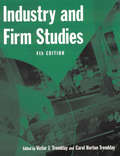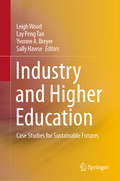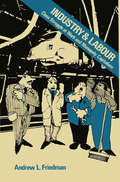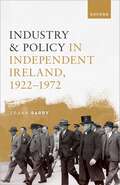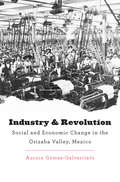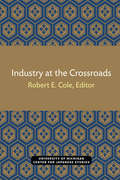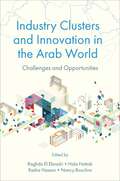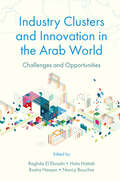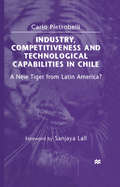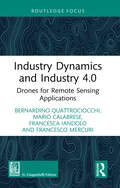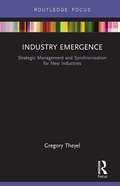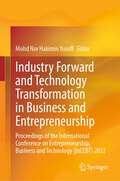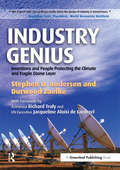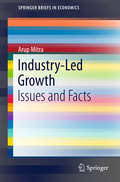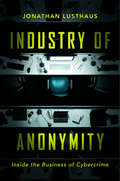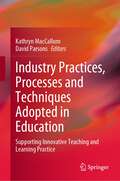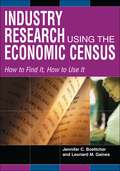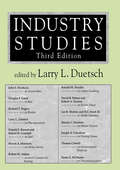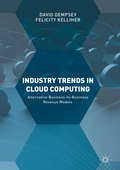- Table View
- List View
Industry and Firm Studies
by Victor J. Tremblay Carol Horton TremblayThe fourth edition of this acclaimed text is a rich resource for undergraduate and graduate courses in industrial organization, applied game theory, and management strategy. It incorporates game theory into industry analysis by studying the behavior of successful and failing firms as well as the structure-conduct-performance of particular industries. Chapters address a wide variety of issues concerning industry structure, policy towards business, and the strategic innovations and blunders of individual firms. New coverage of professional sports, soft drinks, distilled spirits, and cigarettes complements revised and updated chapters on airline services, retail and commercial banking, health insurance, motion pictures, and brewing. The book includes firm case studies of General Motors, Microsoft, Schlitz, and TiVo.
Industry and Firm Studies
by Victor J. Tremblay Carol Horton TremblayThe fourth edition of this acclaimed text is a rich resource for undergraduate and graduate courses in industrial organization, applied game theory, and management strategy. It incorporates game theory into industry analysis by studying the behavior of successful and failing firms as well as the structure-conduct-performance of particular industries. Chapters address a wide variety of issues concerning industry structure, policy towards business, and the strategic innovations and blunders of individual firms. New coverage of professional sports, soft drinks, distilled spirits, and cigarettes complements revised and updated chapters on airline services, retail and commercial banking, health insurance, motion pictures, and brewing. The book includes firm case studies of General Motors, Microsoft, Schlitz, and TiVo.
Industry and Higher Education: Case Studies for Sustainable Futures
by Leigh Wood Lay Peng Tan Yvonne A. Breyer Sally HawseThis book is aimed at business schools around the globe. We offer rich case studies, teaching notes and assessment ideas to help business educators embed sustainability in curriculum. These international case studies are situated in Mauritius, Malaysia, Indonesia, Australia and India however they have global applicability. Each chapter is a joint creation with an industry or government partner and uses original research written in the form of a case study.Active learning through case studies opens opportunities to change attitudes and to find creative solutions. In this book, we present ten chapters written as case studies covering a diverse number of sustainability topics – from tourism, health care, human resource management, climate change and supply chain management. Each case study is accompanied by detailed teaching notes and assessment questions as well as marking guides. There are also two chapters discussing sustainability discourse and discipline in higher education. The detailed cases can be immediately applied in the classroom.
Industry and Policy in Independent Ireland, 1922-1972
by Prof Frank BarryThis book revisits the history of industry and industrial and economic policy in independent Ireland from the birth of the state to the eve of EEC accession. Though there were several manufacturing employers of significance, and smaller firms in operation in almost every major branch of industry, the Irish Free State was predominantly agricultural at its establishment in 1922. Industrial development was high on the nationalist agenda, as would be the case across the entire developing world in the later post-colonial era. Despite decades of protection, and a substantial increase in the size of the manufacturing sector, Ireland remained under-industrialised when it joined the European Economic Community in 1973. Over the previous decade and a half however the foundations of later convergence had been laid. Ireland was an early adopter of what would come to be known as dual-track reform. The policy of attracting outward-oriented foreign direct investment was initiated before substantial trade liberalisation began. By 1972 there had been a significant diversification in export categories and export destinations, and in the nationality of ownership of the leading manufacturing firms. Some of the most successful indigenous companies of the future were also beginning to emerge. In these and other respects the foundations of the economic progress that would be made over the course of EEC membership were already discernible, notwithstanding the post-accession collapse of most protectionist-era businesses. The analysis is supplemented by a unique firm-level database that allows for the identification of the leading manufacturing firms in operation at any stage from the early 1900s through to 1972. The database extends by more than 50 years the period for which estimates of the significance of foreign-owned industry can be provided.
Industry and Policy in Independent Ireland, 1922-1972
by Prof Frank BarryThis book revisits the history of industry and industrial and economic policy in independent Ireland from the birth of the state to the eve of EEC accession. Though there were several manufacturing employers of significance, and smaller firms in operation in almost every major branch of industry, the Irish Free State was predominantly agricultural at its establishment in 1922. Industrial development was high on the nationalist agenda, as would be the case across the entire developing world in the later post-colonial era. Despite decades of protection, and a substantial increase in the size of the manufacturing sector, Ireland remained under-industrialised when it joined the European Economic Community in 1973. Over the previous decade and a half however the foundations of later convergence had been laid. Ireland was an early adopter of what would come to be known as dual-track reform. The policy of attracting outward-oriented foreign direct investment was initiated before substantial trade liberalisation began. By 1972 there had been a significant diversification in export categories and export destinations, and in the nationality of ownership of the leading manufacturing firms. Some of the most successful indigenous companies of the future were also beginning to emerge. In these and other respects the foundations of the economic progress that would be made over the course of EEC membership were already discernible, notwithstanding the post-accession collapse of most protectionist-era businesses. The analysis is supplemented by a unique firm-level database that allows for the identification of the leading manufacturing firms in operation at any stage from the early 1900s through to 1972. The database extends by more than 50 years the period for which estimates of the significance of foreign-owned industry can be provided.
Industry And Revolution: Social And Economic Change In The Orizaba Valley, Mexico (Harvard Historical Studies #182)
by Aurora Gómez-GalvarriatoThe Mexican Revolution has long been considered a revolution of peasants. But Aurora Gómez-Galvarriato's investigation of the mill towns of the Orizaba Valley reveals that industrial workers played a neglected but essential role in shaping the Revolution.
Industry at the Crossroads (Michigan Papers in Japanese Studies #7)
by Robert E. ColeThe mood of the first U of M U.S.-Japan Auto conference in January 1981 could only be described as electric. People wanted to know what our problems were and how we could begin to solve them. Inherent in the latter issue was the questions, what could we learn from the Japanese? One left the conference with a sense that there was a call for action, a mandate to address the problems facing industry. The mood, about a year later, at the March 1982 U.S.-Japan Auto Conference was far more subdued. While undoubtedly this reflected the stream of statistics confirming the continually depressed state of the industry, another dynamic was possibly operating as well. Whereas the 1981 conference was "electric," a state of mind which flowed from a certain frustration at seemingly overwhelming difficulties and often vague expectations of what we might learn from the Japanese, the 1982 conference was more "workmanlike" in the sense that speakers discussed specifically what progress was being made in addressing problems. This more subdued, pragmatic approach continued throughout wand was reinforced by workshops held the day after the main conference. Instead of discussing the virtues of the Just-In-Time system in Japan, speakers addressed the practical problems of introducing such a system in the U.S. firms. Instead of railing about the benefits or failings of regulation of the industry, they discussed what we could reasonably expect from regulation. Instead of exhorting the industry to adopt Japanese practices willy-nilly, they focused on some of the limitations of the Japanese model in a range of different areas. Instead of trying to identify some magic key to Japanese success in the automotive industry, they discussed the interrelationships among various factors. At the same, they continued to explore the basic issues transforming the auto industry worldwide. In this connection, they sought to unravel some of the complexities associated with the internalization of the auto industry and trade obligations under the GATT.
Industry Clusters and Innovation in the Arab World: Challenges and Opportunities
by Raghda El Ebrashi Hala Hattab Rasha Hassan Nancy BouchraIndustry clusters promote innovation in the Arab World, through collaboration among businesses, research institutions, and governments. Benefits include the creation and sharing of knowledge, professional networking, access to spill-over knowledge, and specialized talent pools. These are the necessary elements to support the blossoming of innovation. In addition, clusters have the capacity to foster economic development in the region as a whole. They are key determinants in improving micro and small firms’ performance through company linkages and access to internationalization opportunities. Industry Clusters and Innovation in the Arab World presents research and case studies in a range of Arabic-speaking countries, and proposes a series of reforms to build and promote industry clusters in the region. Challenges facing the establishment and the competitiveness of such clusters are also explored, and real-world applicable recommendations are provided. This break-through research highlights opportunities, and also macro-environmental threats. This is essential reading for researchers, policy-makers, and practitioners.
Industry Clusters and Innovation in the Arab World: Challenges and Opportunities
by Raghda El Ebrashi, Hala Hattab, Rasha S. Hassan, Nancy H. BouchraIndustry clusters promote innovation in the Arab World, through collaboration among businesses, research institutions, and governments. Benefits include the creation and sharing of knowledge, professional networking, access to spill-over knowledge, and specialized talent pools. These are the necessary elements to support the blossoming of innovation. In addition, clusters have the capacity to foster economic development in the region as a whole. They are key determinants in improving micro and small firms’ performance through company linkages and access to internationalization opportunities. Industry Clusters and Innovation in the Arab World presents research and case studies in a range of Arabic-speaking countries, and proposes a series of reforms to build and promote industry clusters in the region. Challenges facing the establishment and the competitiveness of such clusters are also explored, and real-world applicable recommendations are provided. This break-through research highlights opportunities, and also macro-environmental threats. This is essential reading for researchers, policy-makers, and practitioners.
Industry, Competitiveness and Technological Capabilities in Chile: A New Tiger from Latin America?
by Carlo PietrobelliChile's export diversification and industrial development since 1974 represents a laboratory case of market liberalization based on neoclassical principles. Advocated by the World Bank as the chief development strategy for most developing countries, Chile implemented what the World Bank is recommending as the lesson of East Asia. The book examines whether the continuous implementation of these policies since 1974 turned Chile into a Tiger. This book investigates these issues in detail with original evidence and analyses at the macro, industrial and microeconomic levels.
Industry Dynamics and Industry 4.0: Drones for Remote Sensing Applications (Routledge-Giappichelli Studies in Business and Management)
by Bernardino Quattrociocchi Mario Calabrese Francesca Iandolo Francesco MercuriThe so-called Fourth Industrial Revolution has prompted companies to adapt to a new business paradigm based on digital interconnection and the ability to respond quickly to the needs of consumers and users. These conditions are closely related to the advent of digital technologies that enable the real-time integration of devices and the control of production systems through technological platforms. Based on this logic, this volume aims to investigate the forms and methods being used by the company at present to confront the new business paradigm, commonly known as Industry 4.0, as well as the impact of new digital technologies on corporate evolutionary dynamics and related business models. More specifically, technological challenges will assess the impact of new technologies on productivity and investment in complementary resources—including human, organizational, and managerial capital—as well as the effects related to the introduction of Internet of Things (IoT)-based production processes. By following this approach, the focus subsequently shifts to drone technology, which is considered by many to be one of the most revolutionary Industry 4.0 technologies. In addition to investigating the history and potential applications of drones, many of which proved to be fundamental during the COVID-19 pandemic, the volume emphasizes the related ethical and social aspects such as the degree of knowledge regarding and the public acceptance of drones. The academic and professional approach of this volume allows it to serve as a guide for professionals, entrepreneurs, and academics with a particular interest in both digital innovation and the drone sector.
Industry Dynamics and Industry 4.0: Drones for Remote Sensing Applications (Routledge-Giappichelli Studies in Business and Management)
by Bernardino Quattrociocchi Mario Calabrese Francesca Iandolo Francesco MercuriThe so-called Fourth Industrial Revolution has prompted companies to adapt to a new business paradigm based on digital interconnection and the ability to respond quickly to the needs of consumers and users. These conditions are closely related to the advent of digital technologies that enable the real-time integration of devices and the control of production systems through technological platforms. Based on this logic, this volume aims to investigate the forms and methods being used by the company at present to confront the new business paradigm, commonly known as Industry 4.0, as well as the impact of new digital technologies on corporate evolutionary dynamics and related business models. More specifically, technological challenges will assess the impact of new technologies on productivity and investment in complementary resources—including human, organizational, and managerial capital—as well as the effects related to the introduction of Internet of Things (IoT)-based production processes. By following this approach, the focus subsequently shifts to drone technology, which is considered by many to be one of the most revolutionary Industry 4.0 technologies. In addition to investigating the history and potential applications of drones, many of which proved to be fundamental during the COVID-19 pandemic, the volume emphasizes the related ethical and social aspects such as the degree of knowledge regarding and the public acceptance of drones. The academic and professional approach of this volume allows it to serve as a guide for professionals, entrepreneurs, and academics with a particular interest in both digital innovation and the drone sector.
Industry Emergence: Strategic Management and Synchronization for New Industries
by Gregory TheyelThis book develops a novel industry emergence framework to explain the features, interaction, and synchronization of key elements for the birth and growth of new industries.Organized around seven elements—firm strategy, technology, investment, supply networks, production, markets, and government—Theyel’s framework provides inventors, managers, investors, scholars, and policymakers with a comprehensive understanding of how industries emerge, helping them to be more successful at influencing the birth and growth of new industries. Understanding industry emergence is important because new industries can offer the advancement of technology, improvements in human health and the environment, growth of firms, creation of jobs, and economic development. With learning objectives, theory, tools, case studies, and end-of-chapter questions, Industry Emergence will be a useful resource for students and professionals in engineering, science, business, and policy.
Industry Emergence: Strategic Management and Synchronization for New Industries
by Gregory TheyelThis book develops a novel industry emergence framework to explain the features, interaction, and synchronization of key elements for the birth and growth of new industries.Organized around seven elements—firm strategy, technology, investment, supply networks, production, markets, and government—Theyel’s framework provides inventors, managers, investors, scholars, and policymakers with a comprehensive understanding of how industries emerge, helping them to be more successful at influencing the birth and growth of new industries. Understanding industry emergence is important because new industries can offer the advancement of technology, improvements in human health and the environment, growth of firms, creation of jobs, and economic development. With learning objectives, theory, tools, case studies, and end-of-chapter questions, Industry Emergence will be a useful resource for students and professionals in engineering, science, business, and policy.
Industry Forward and Technology Transformation in Business and Entrepreneurship: Proceedings of the International Conference on Entrepreneurship, Business and Technology (InCEBT) 2022
by Mohd Nor Hakimin YusoffThis book, bringing together selected papers from the 10th International Conference on Entrepreneurship, Business and Technology (InCEBT) on the overarching theme of ‘Industry Forward and Technology Transformation in Business and Entrepreneurship’, provides the audience some preliminary understanding of the current and emerging trends in entrepreneurship and business activities. This includes the usage of information and digital technology in business, competition in a digital economy, its challenges and opportunities, and transformation of business and entrepreneurship for the forward industry.
Industry Genius: Inventions and People Protecting the Climate and Fragile Ozone Layer
by Stephen Andersen Durwood ZaelkeThis book presents the inventive genius behind technological breakthroughs by ten global companies including Alcoa, DaimlerChrysler, Honda, ST Micro and Visteon. Readers will gain understanding and insight into how cutting-edge technology is helping protect the climate and/or the ozone layer, while contributing to the company's bottom line. Each chapter chronicles the challenge and triumph of invention, introduces the engineers and executives who overcome conventional wisdom, and demonstrates the contribution these companies are making to environmental protection. In full colour and crammed with graphics to illustrate the creative process of technological breakthroughs, the book is accessible and informative. The genius of these ten companies will inspire the engineer, the policy-maker, the student, the environmentalist, the CEO and the investor alike.
Industry-Led Growth: Issues and Facts (SpringerBriefs in Economics #0)
by Arup MitraThe book explores, for India and other developing countries, the potential role the organized manufacturing sector could play as an engine of growth. Alongside growth, can this sector generate adequate employment opportunities to facilitate the transfer of labour from the agriculture sector? The book identifies the major constraints that result in limited demand for labour in the organised manufacturing sector. Beyond technological aspects, skill shortage is an important factor, resulting in sluggish labour absorption. Further, the labour market laws are not necessarily the root cause of sluggish employment growth in the organised manufacturing sector. The development of technologies that are appropriate for labour surplus countries like India is instrumental to employment creation. Though innovation is generally assumed to be capital-intensive in nature, the book argues that innovation nevertheless has a positive effect on employment in absolute terms. Lastly, the main policy issues are highlighted in terms of the priority that should be assigned to industries which can contribute to employment growth and skill formation for improving the employability of the available labour force, and to which innovations should be pursued, with a specific focus on pro-poor growth objectives.
Industry of Anonymity: Inside the Business of Cybercrime
by Jonathan LusthausJonathan Lusthaus lifts the veil on cybercriminals in the most extensive account yet of the lives they lead and the vast international industry they have created. Having traveled to hotspots around the world to meet with hundreds of law enforcement agents, security gurus, hackers, and criminals, he charts how this industry based on anonymity works.
Industry Practices, Processes and Techniques Adopted in Education: Supporting Innovative Teaching and Learning Practice
by Kathryn MacCallum David ParsonsThis book provides a single source of reference for educators interested in understanding how industry-based ideas have been adapted into different educational contexts, and supports their utilisation in practice. The link between industry-based ideas and their application in education has enabled educators to develop engaging, collaborative, and creative learning environments, as well as better preparing their students for an increasingly complex and dynamic global environment. This book includes contributions from educators, researchers, and practitioners, who have integrated industry-based ideas into their teaching, and explores how these concepts and practices support the creation of effective learning environments. Through these diverse, international contributions, this book enables wider engagement with, and critical analysis of, the application of industry practices, processes and techniques in the development of collaborative and creative learning environments.
Industry Research Using the Economic Census: How to Find It, How to Use It (How to Find It, How to Use It)
by Jennifer C. Boettcher Leonard M. GainesMany business researchers, from novice to expert, have been amazed to find that the answers to their questions could be found in the Economic Censuses provided by the U.S. government. Until now, there have been no comprehensive guides to this valuable resource. Industry Research Using the Economic Census explains Census concepts, methods, terminology, and data sources in an understandable manner, and assists Census users in locating needed Census data. Designed as a working handbook, it does not duplicate the data from the census, but introduces users to the features, uses, and formats of the data. This guidebook also discusses the important changes that the 1997 and 2002 Economic Censuses introduced from previous versions. Librarians, businesspeople, researchers, faculty, and students will find this guide valuable for mining the riches found in the Economic Censuses.
Industry Structure and Pricing: The New Rivalry in Infrastructure (Studies in Industrial Organization #22)
by Mark A. JamisonIndustry Structure and Pricing: The New Rivalry in Infrastructure extends current economic models by incorporating effects of actual and potential rivalry in markets outside the markets of immediate interest. Focusing on the contestable model, the author shows how diverse patterns of actual and potential rivalry, called multilateral rivalry or MLR, affect the appropriateness of many regulatory policies. It is specifically shown that many conclusions of the contestability literature are overly generous to firms that might want to protect or extend their monopoly positions. While this book's refinement to existing economic theory gives strong results, it is still based on static production functions and demands - integrated to provide a dynamic view of multilateral rivalry.
Industry Studies
by Larry L. DuetschFeaturing new chapters on casino gambling and the nursing home industry, and updated throughout, the new edition of this highly readable text analyzes well-defined industries from commodities and manufacturing to distribution and services, showing how firms compete with one another. Each study gives appropriate attention to government policies that have influenced competitive conditions in the industry, and the material is presented without the use of calculus so that anyone with some background in economic principles can benefit from it. The book provides balance in regard to the mix of industries dealt with, and also in the varying perspectives of the contributors.
Industry Studies
by Larry L. DuetschFeaturing new chapters on casino gambling and the nursing home industry, and updated throughout, the new edition of this highly readable text analyzes well-defined industries from commodities and manufacturing to distribution and services, showing how firms compete with one another. Each study gives appropriate attention to government policies that have influenced competitive conditions in the industry, and the material is presented without the use of calculus so that anyone with some background in economic principles can benefit from it. The book provides balance in regard to the mix of industries dealt with, and also in the varying perspectives of the contributors.
Industry Trends in Cloud Computing: Alternative Business-to-Business Revenue Models
by David Dempsey Felicity KelliherExploring the Cloud Computing (CC) commercial landscape as it matures; this book asserts that the key ingredient in sustaining the Software as a Service (SaaS) business model is subscription renewal. Chronicling the evolution and future trajectory of the CC concept, the authors examine the new paradigm it is creating for the distribution of computer software applications among business-to-business (B2B) clients. CC enabled SaaS has been fundamentally changing the revenue expectations and business model for the application software industry, and impacting on how SaaS providers pursue, acquire and retain B2B clients. Securing SaaS subscription renewal is critical to the survival and prosperity of this business as attrition can have a significant impact on the financial viability of SaaS businesses based on this model. Focusing on the B2B client and the SaaS industry dependency on renewal subscriptions delivered through the CC channel, the primary research presented in this book seeks to examine the key drivers behind the B2B SaaS subscription renewal decision and, in doing so, to explore the recurring revenue framework for the Cloud SaaS business.
